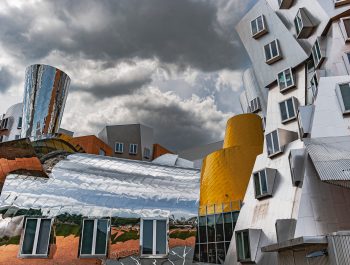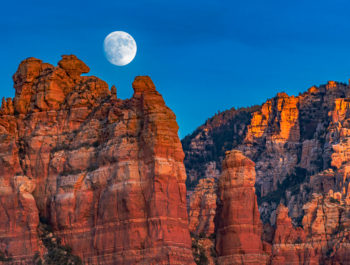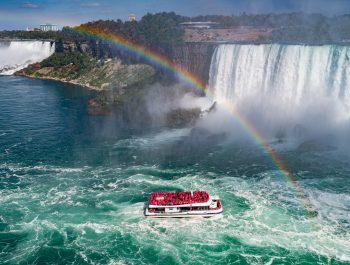Cityscapes: Ideas for the Urban-bound Photographer
6-Part Series By Harvey Stearn
Over my past 72 years of making photographic images, I have viewed myself as a nature photographer. Lately, I’m not so sure, as my photography evolved more broadly toward graphic art in rich natural color and monochrome images of subjects found in human environments as well as in Nature.
My photographic inventory includes many images made on impulse in cities visited during vacation travel. What they have in common with Nature photography is that they are graphic and colorful and often tell stories. They fit a lesser-known branch of photography called “Cityscapes”, and in many cases also belong to an important specialty known as “Travel Photography”.
I organized this Cityscapes series into six groups to see if this would help readers select locations and materials for their own art photography.
- Architecture and Skylines
- Coastal and River Cities
- Local Color
- Major Events
- Parks, Gardens & Public Places
- Urban Wildlife
Cityscapes Part III – Local Color
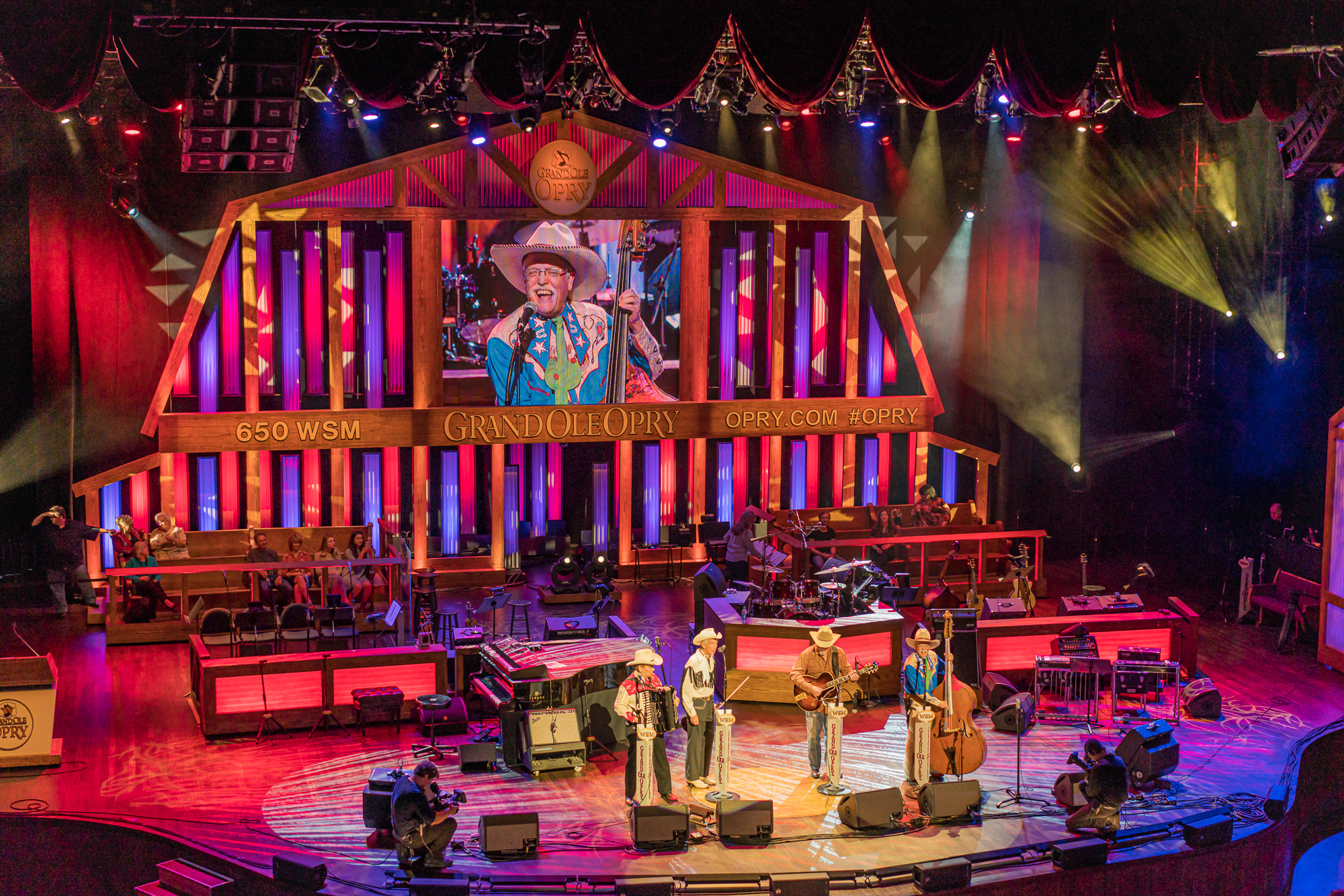
“Local color” has more to do with the culture of a city or town than anything else. Often a preponderance of bright color is part of that culture, particularly in Latin America. Most of the images selected for this article are literally colorful. The others highlight local culture in other ways.
The following five images were taken in Valparaiso, Chile, where “Street Art” has a long and important history that was strongly influenced by two men. The first one, Pablo Neruda, was a diplomat who served as Chile’s Consul General in Mexico City until 1943. While there, he was taken by the role that outdoor art played in making a large city more friendly and enjoyable. When he returned to his native Valparaiso, he convinced the city to exhibit the works of local artists in outdoor venues. Neruda was also a writer who received a Nobel Prize for poetry.
The second man was General Pinochet, who led a coup to destroy Chile’s democracy. Within months, Pinochet had Neruda imprisoned and executed. Pinochet was ruthless and aware of the dual role Street Art could serve by incorporating political messages in artistically rendered murals. Though he banned such art and imposed severe penalties on artists who were caught, many artists continued to paint at night on quiet streets, producing vivid images of Pinochet’s tyranny.
In 1990, Pinochet was voted out of office, and his repressive military junta was replaced by a democratic government. Not only was Street Art again permitted, but it was also formally encouraged, as local politicians felt it necessary to dress up Valparaiso, which had fallen into disrepair. Once more, the city’s Street Art became inspirational, and the city attracted visitors from around the world.
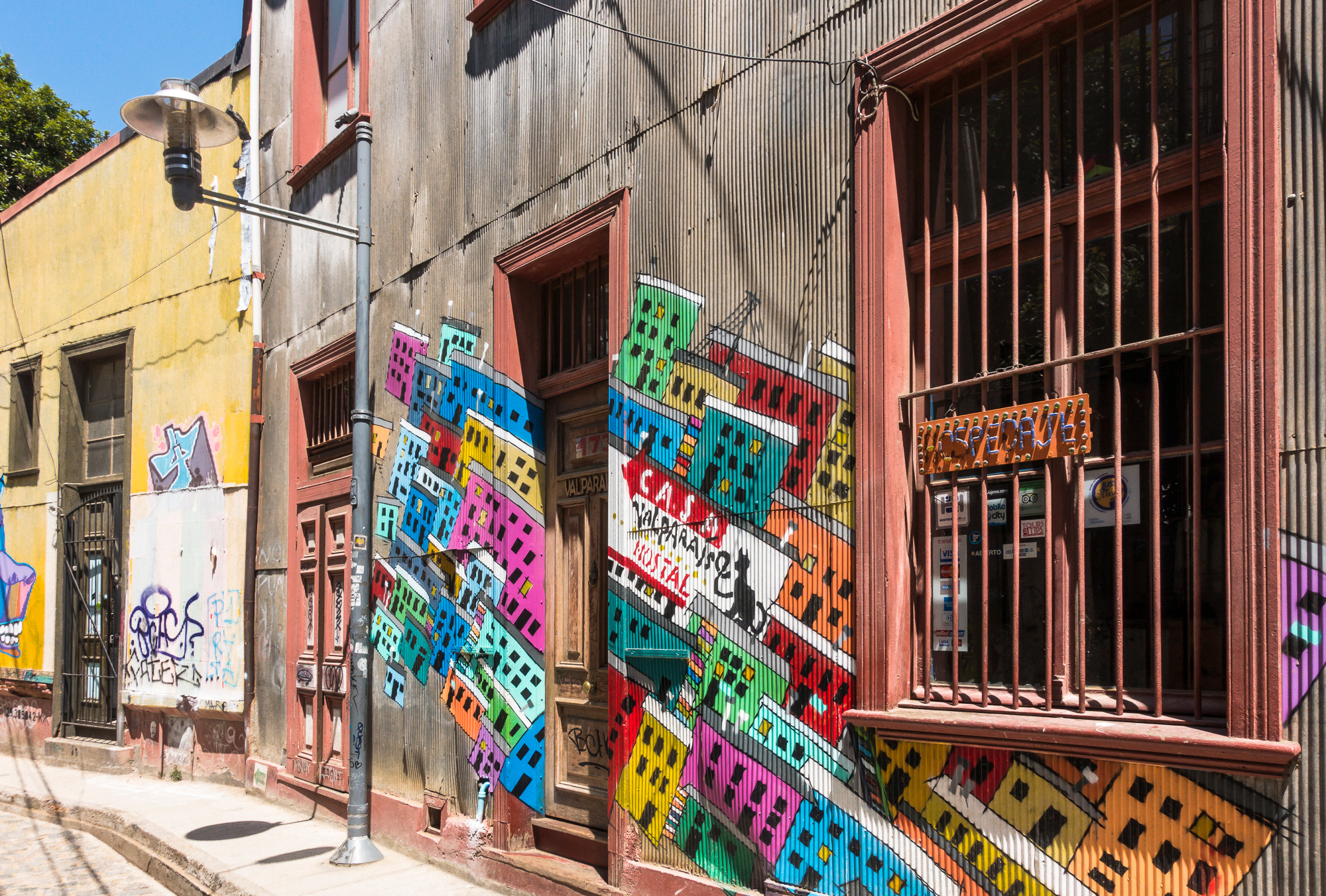
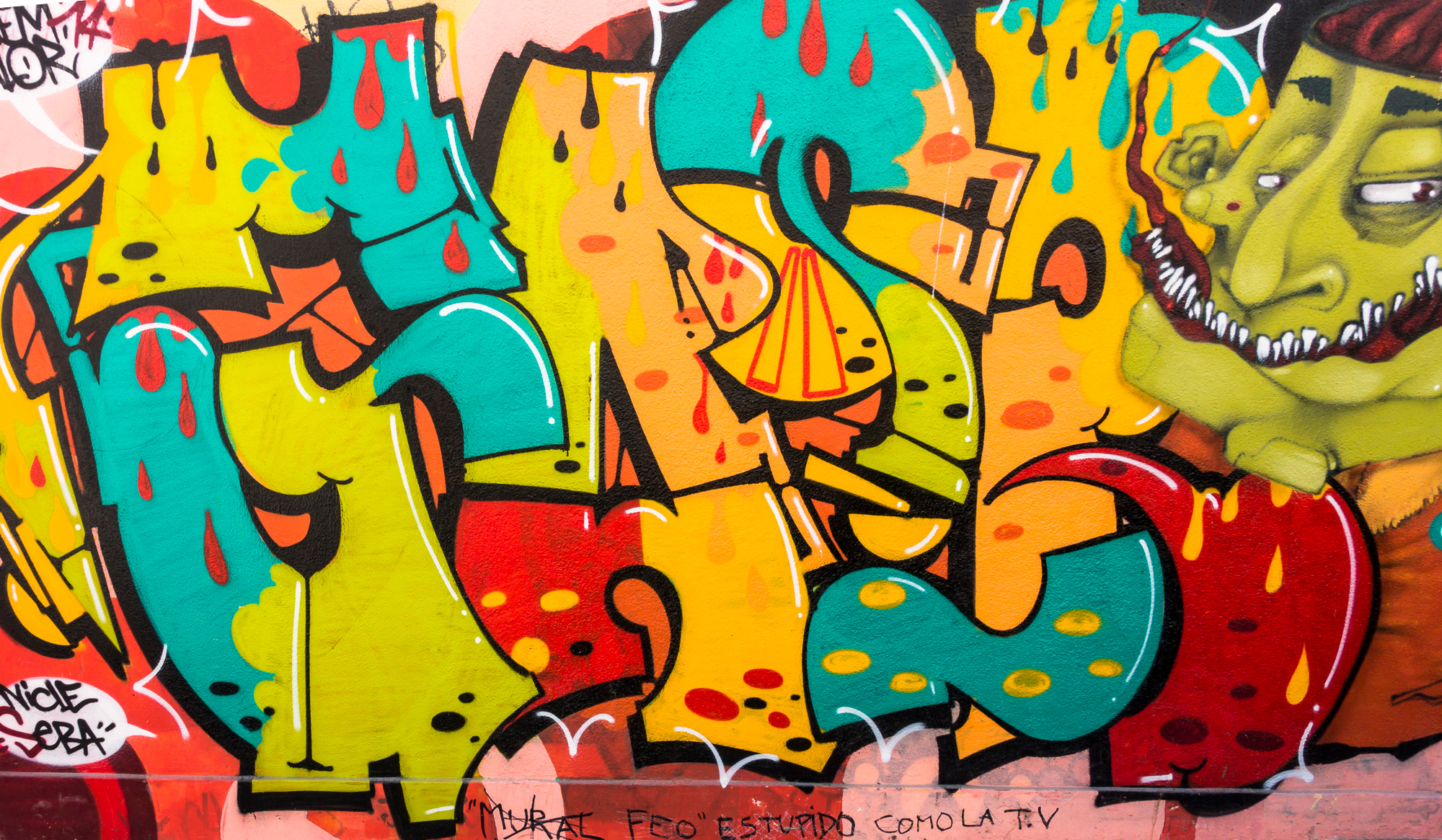
A graffiti critique scrawled above the street painting states, “Mural is stupid like TV.”
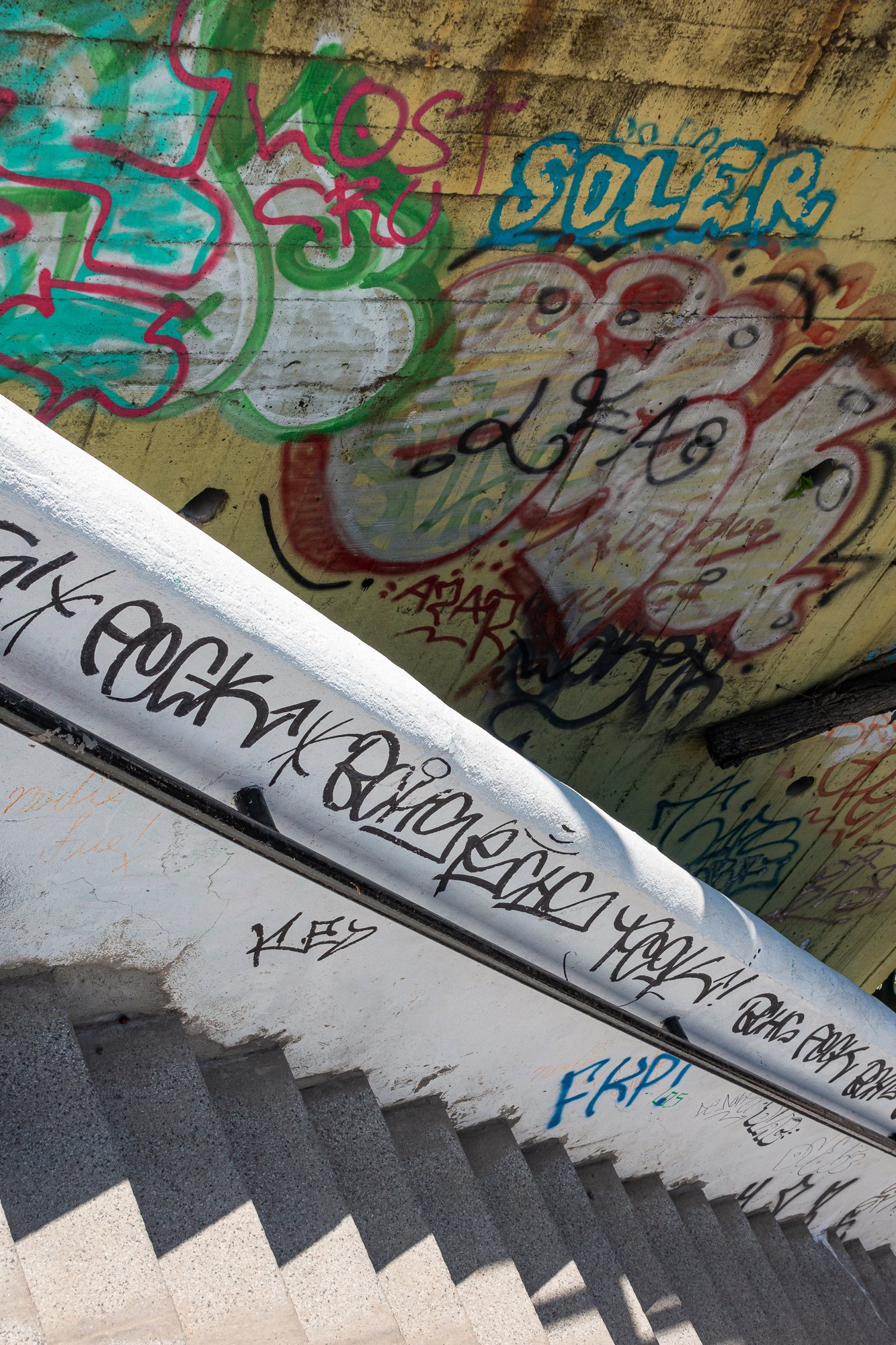
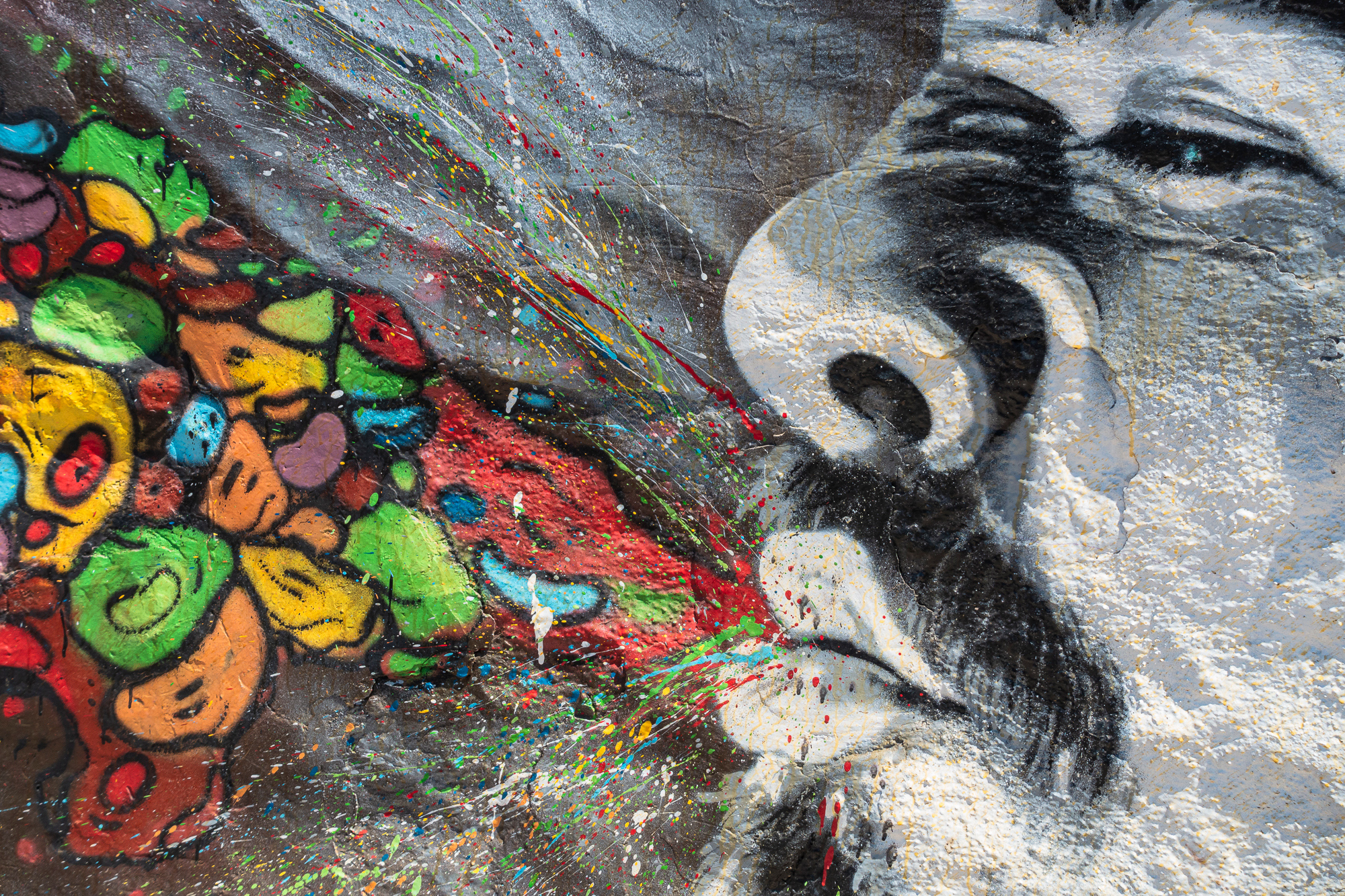
The above outdoor mural appears to be a political statement of a politician spewing garbage from his mouth. The face bears a resemblance to Pinochet. If this is so, then this is either a Pinochet-era mural or a new one to remind Chileans of the evils of dictatorships.
The image shown below is a good example of using bright-colored paints to dress up urban blight.
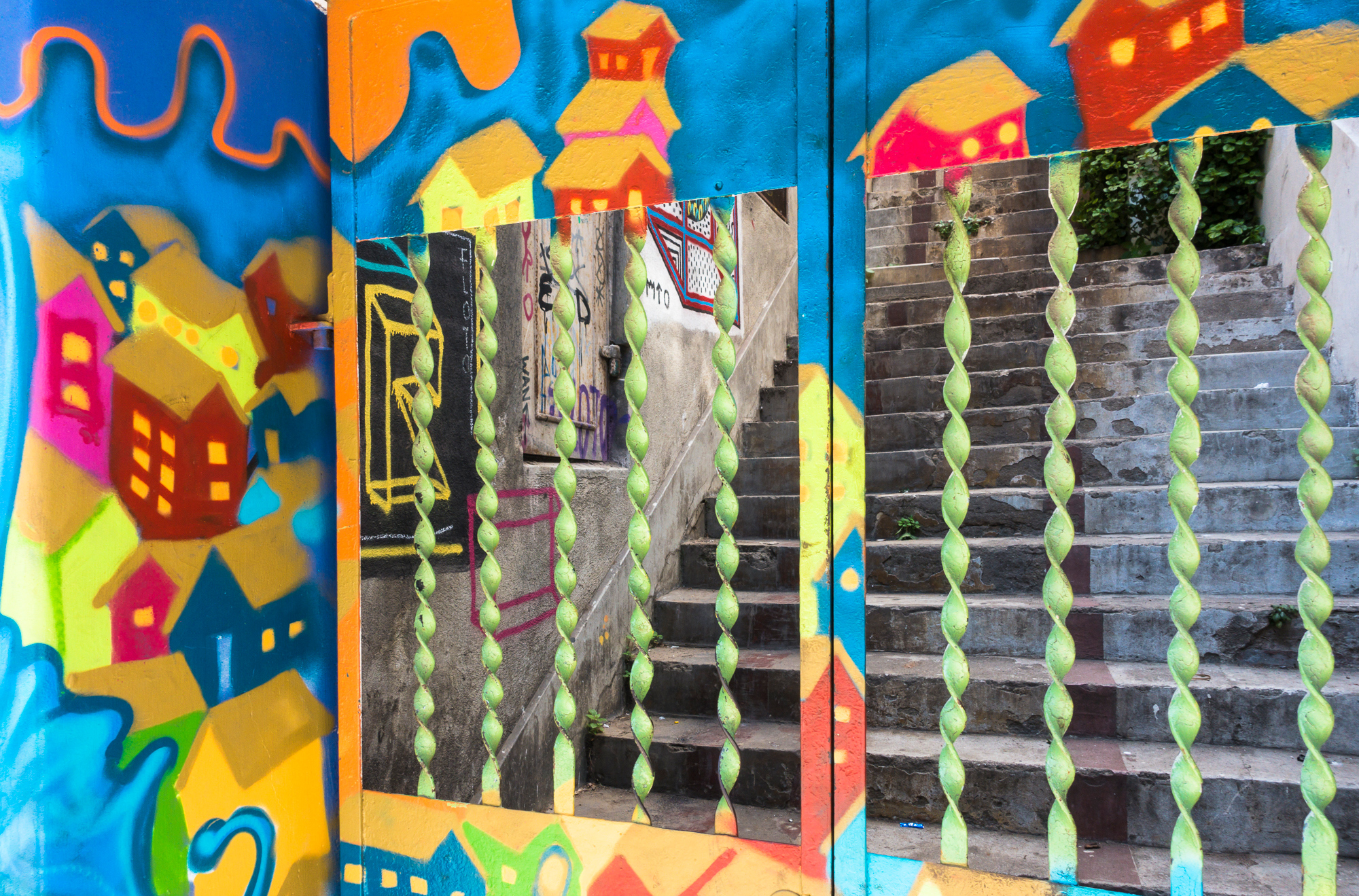
Perhaps one of the most colorful areas in Buenos Aires, Argentina, is the old Italian Quarter. The use of colored paint to dress up old tin sheeting and walls is like what is practiced in Valparaiso, Chile as seen in the image below.
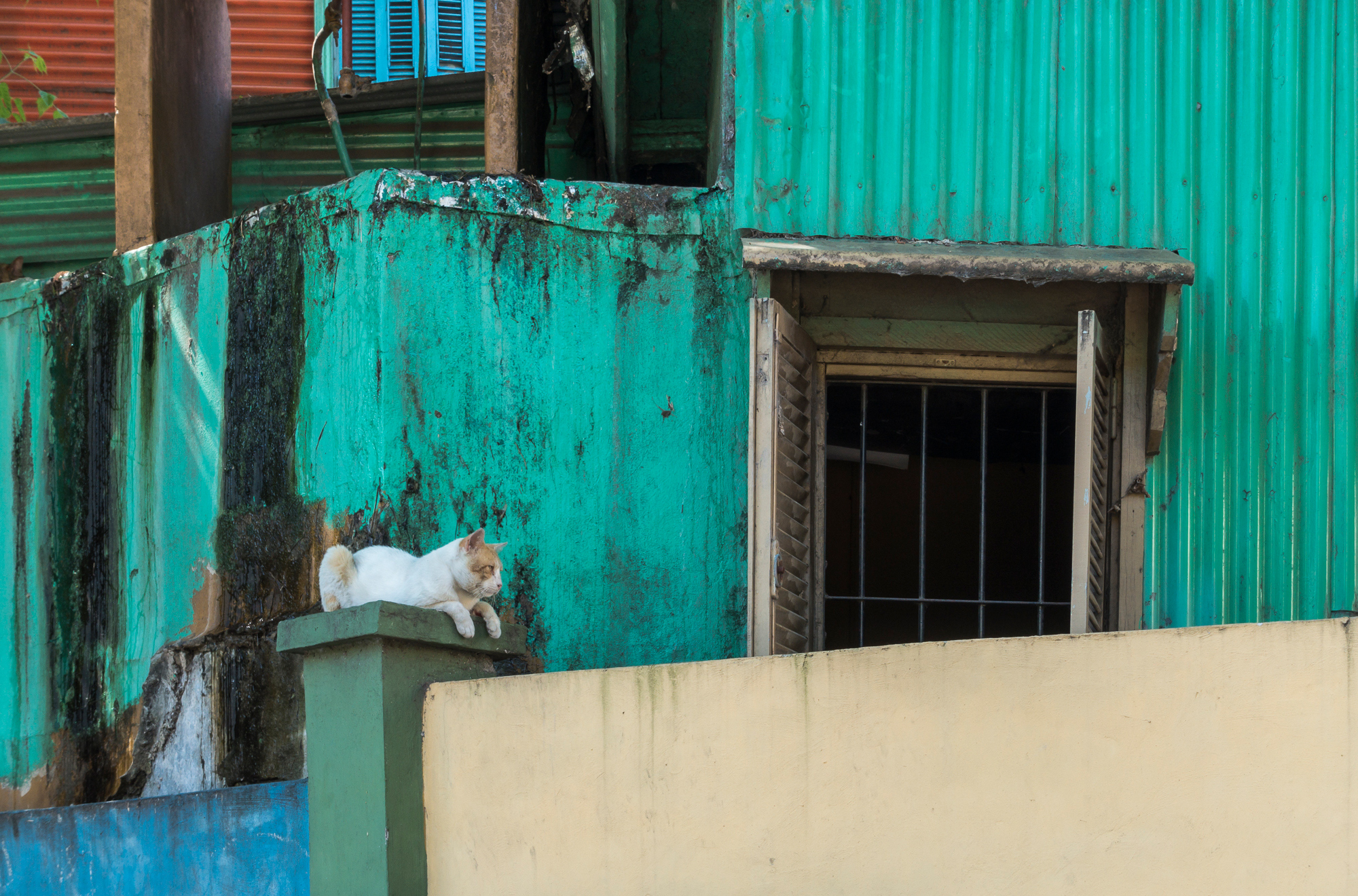
One other common sight in the Buenos Aires Italian Quarter is young adults whose shared passion is Tango dancing.
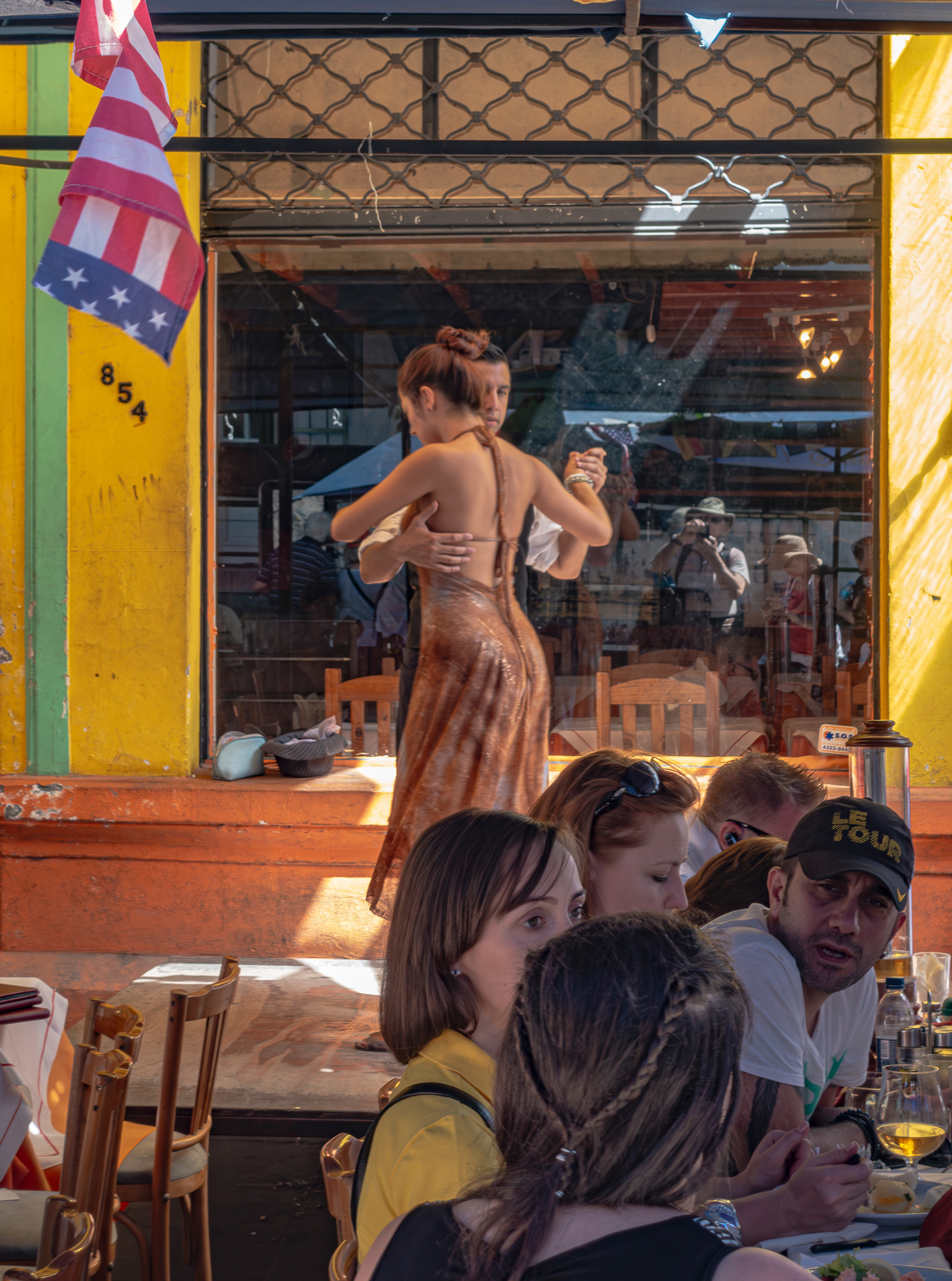
The following three images were taken on three different continents and are of residents within their immediate environments.
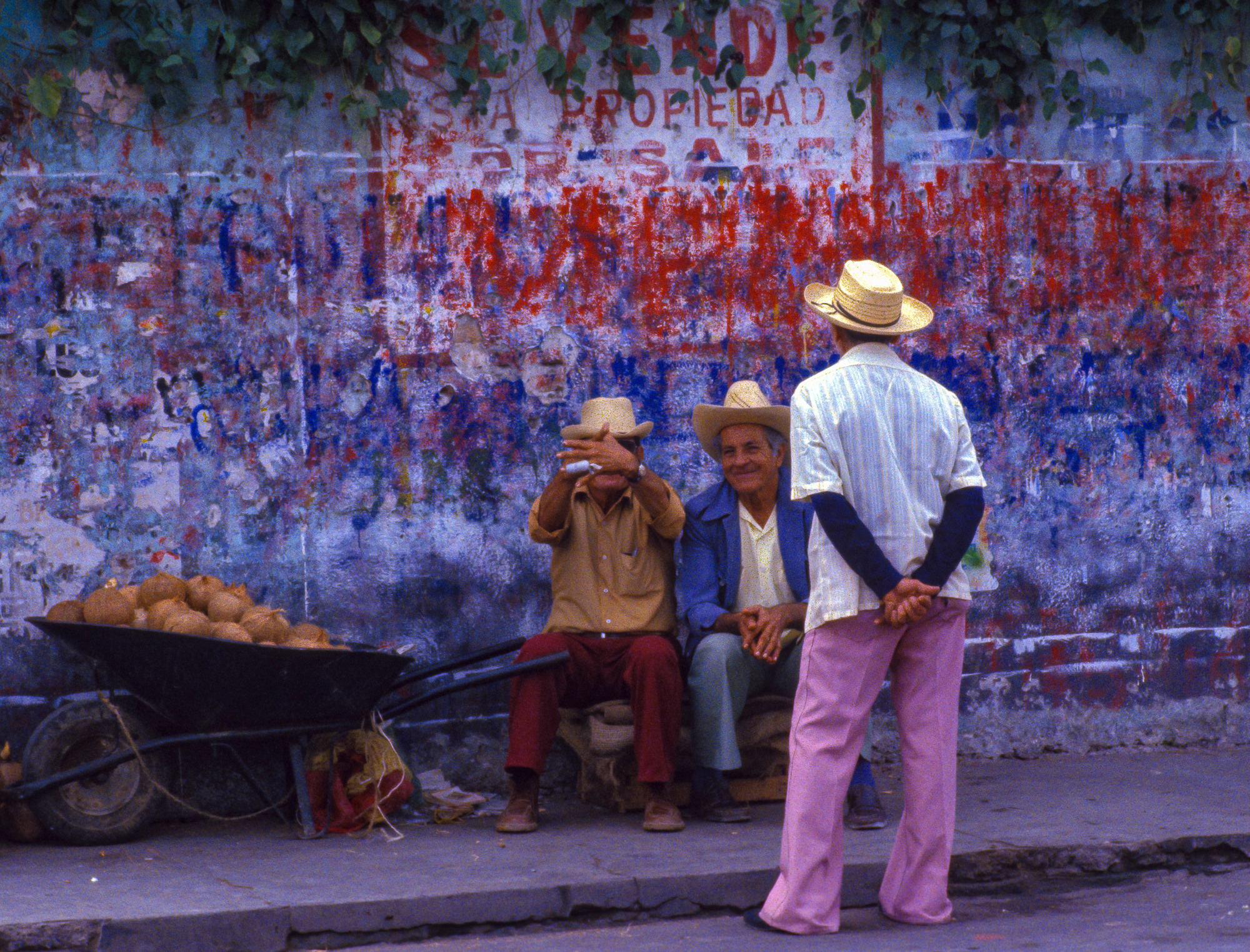
This is an old Kodachrome image that I took in Guadalajara in 1967. I was primarily interested in photographing the wall with its layers of brightly colored graffiti. For me, at that early stage in my photography practice, the three vendors were an unavoidable complication. The man covering his face with one finger extended thought I wanted to photograph them and was communicating to me that I would have to pay him one peso for the privilege. When I got this image back from the Kodak laboratory, I realized how important these locals were to this image. It is a wonderful illustration of “Local Color”.
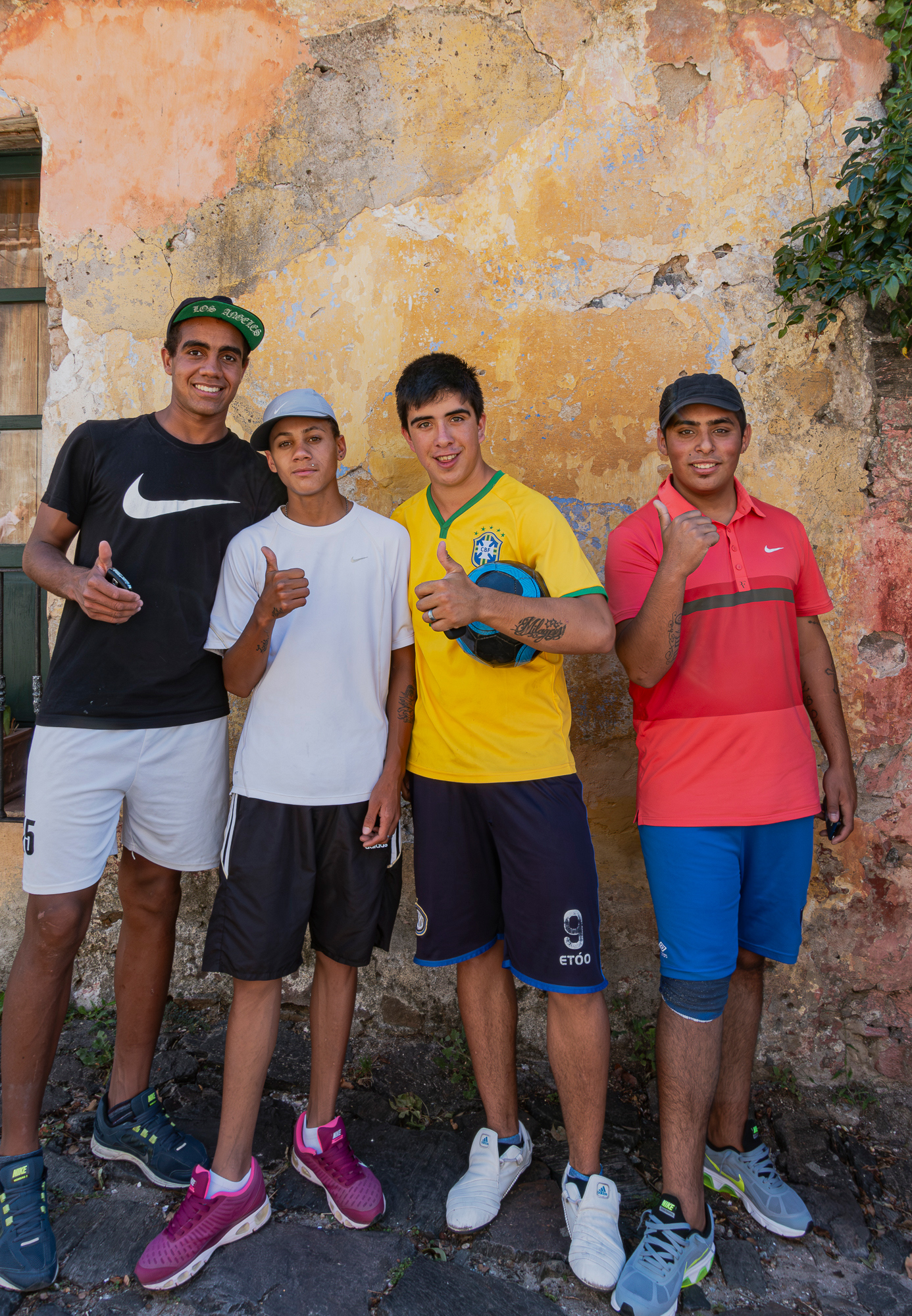
As I was in South America photographing the 17th-century Portuguese buildings in Colonia del Sacramento, Uruguay (see Part I – Architecture), these four young Uruguayans ran up to me and asked me to take their picture. They were all dressed up in their soccer clothes and brand-new sneakers and did me a great favor, as this is one of the best group portraits that I have ever made.
Immediately below is the third informal portrait. It was taken in Old Corfu, a Greek island. Once again, I was photographing Mediterranean architecture. But, this time, I was immediately drawn to the second story of a building overlooking the central plaza. I don’t know for sure, but I suspect that this old woman’s best friends were her pigeons, which she fed regularly. She was not expecting human company as she was dirty and disheveled, and her pigeon friends didn’t care. Despite her condition, I was, and still am, moved by this scene. And she was a perfect illustration of “Local Color”.
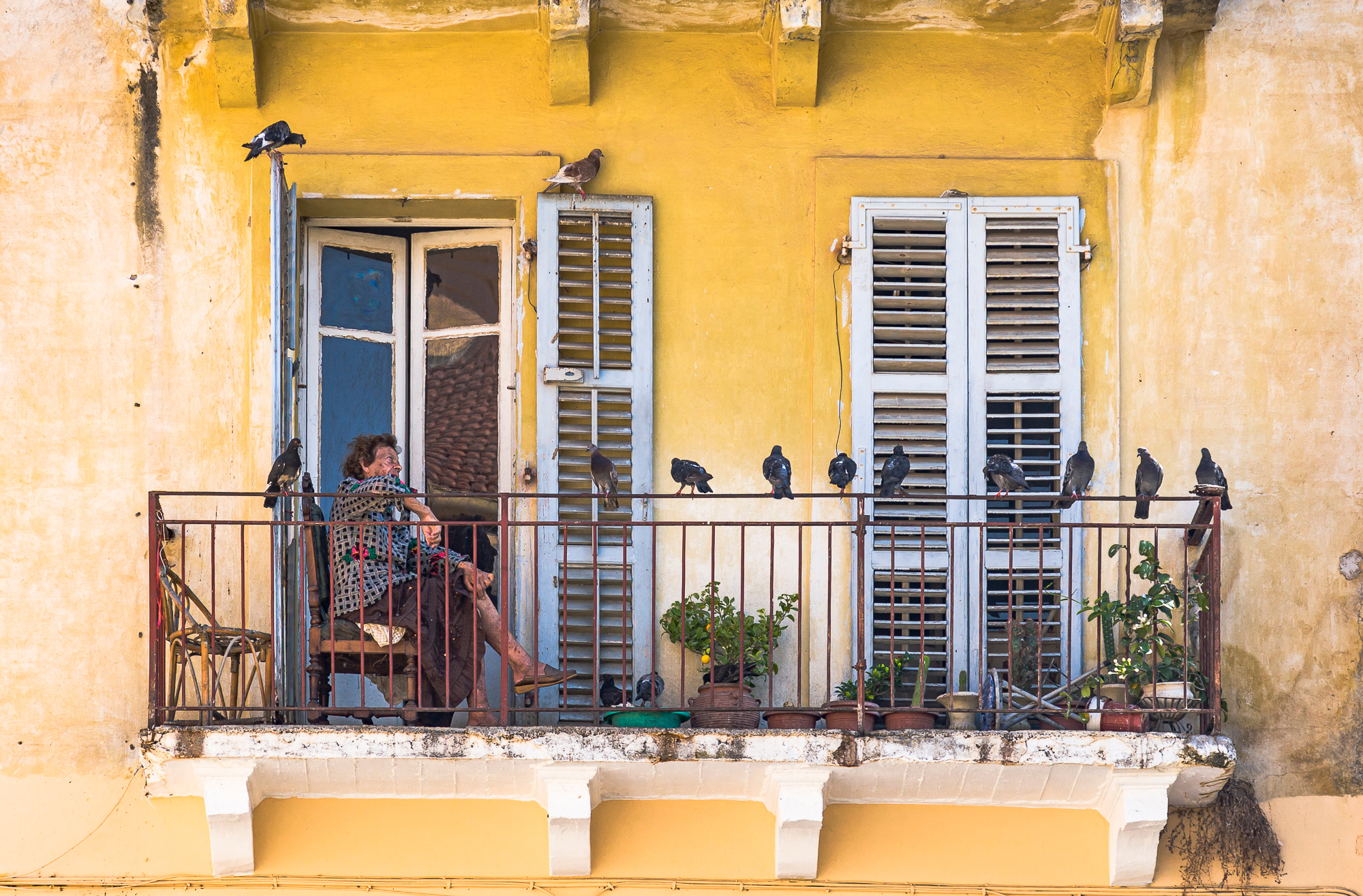
The City of Rome has many plazas with apartment buildings and stores built around a central meeting area. Among the best-known plazas is the one containing the fountain and sculpture named Fontana di Trevi and completed by Pannini. Visitors who spend enough time in Rome will see less elaborate plazas that contain stores rather than monuments.
The following image was taken in one of those lesser-known plazas, which happened to contain a store that had been vacant for a long time. Though it was largely empty, the store window was filled with many old dolls and doll heads that had been there – untouched – for years. Once again, it was my wife who called my attention to this scene. I photographed the window with color negative film and, years later, digitized the image. The final version uses a digital filter to enhance the feeling of age and decay further. To me, this echoes the feeling that visitors might have to a city that contains so much antiquity and so many ruins. In this case, local color refers to that pervasive quality.
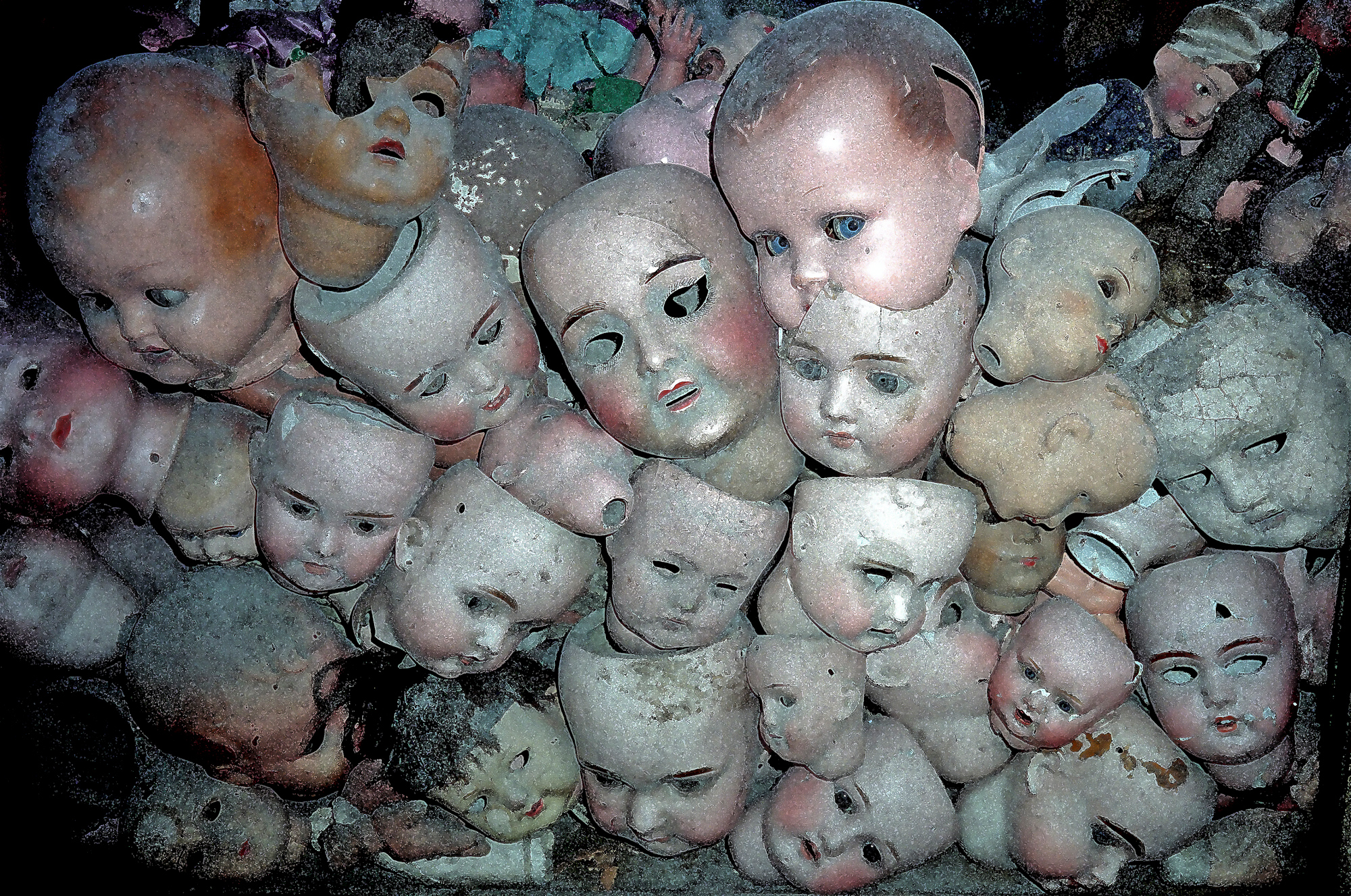
One city that lies on the opposite part of the age spectrum is Las Vegas, Nevada. Though the greater Las Vegas area spreads across the desert floor and has a population exceeding 2.6 million people, the Strip and the major hotels built since 1950 define the popular image of this desert town. Its appeal is built on excesses of different kinds, one of which is bright lights and colors. In particular, the newer hotels with bold colors and shapes specialize in “eye candy”. In Las Vegas, “local color” is color, bright and saturated, as typified by the next two images.
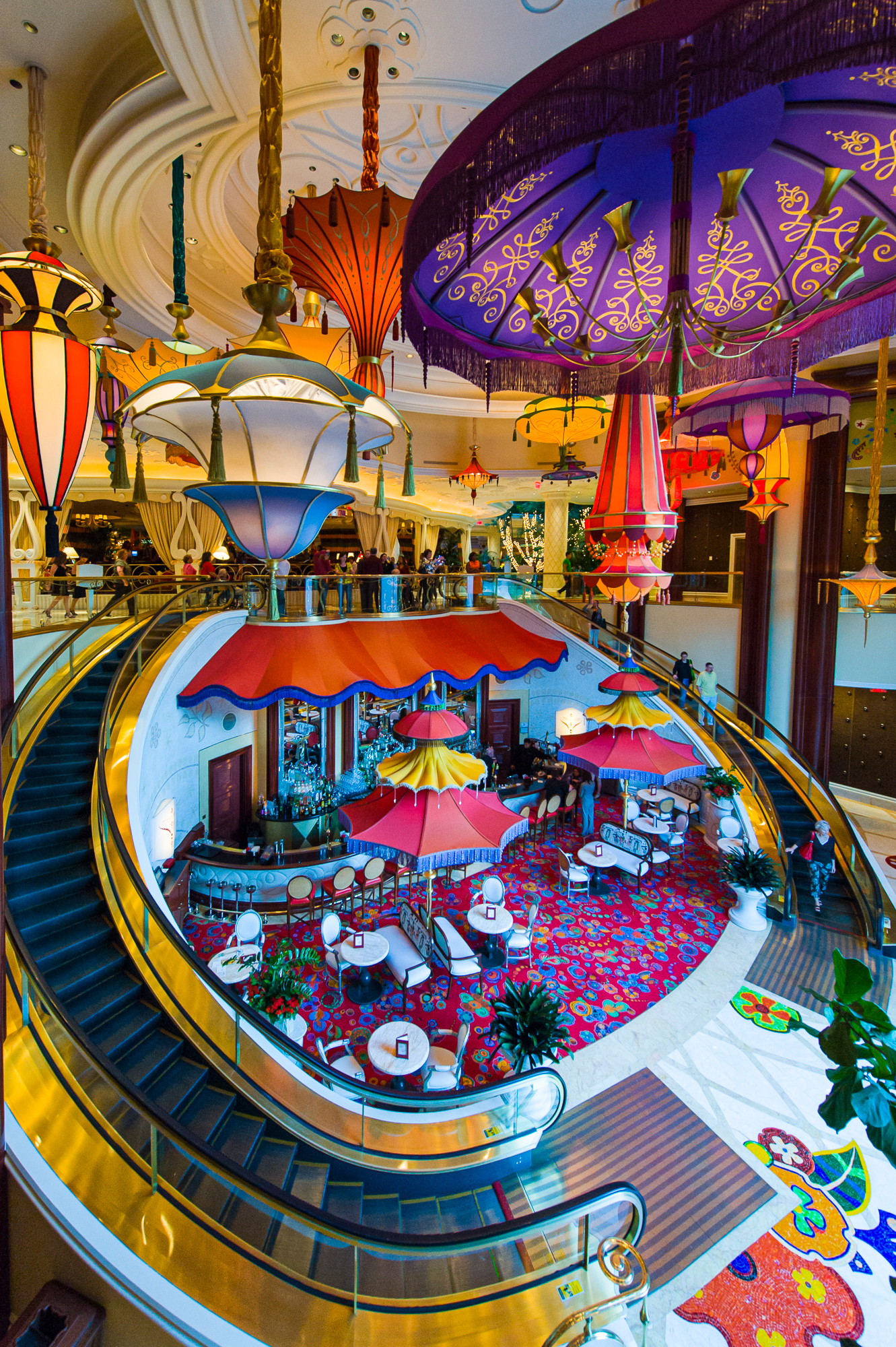
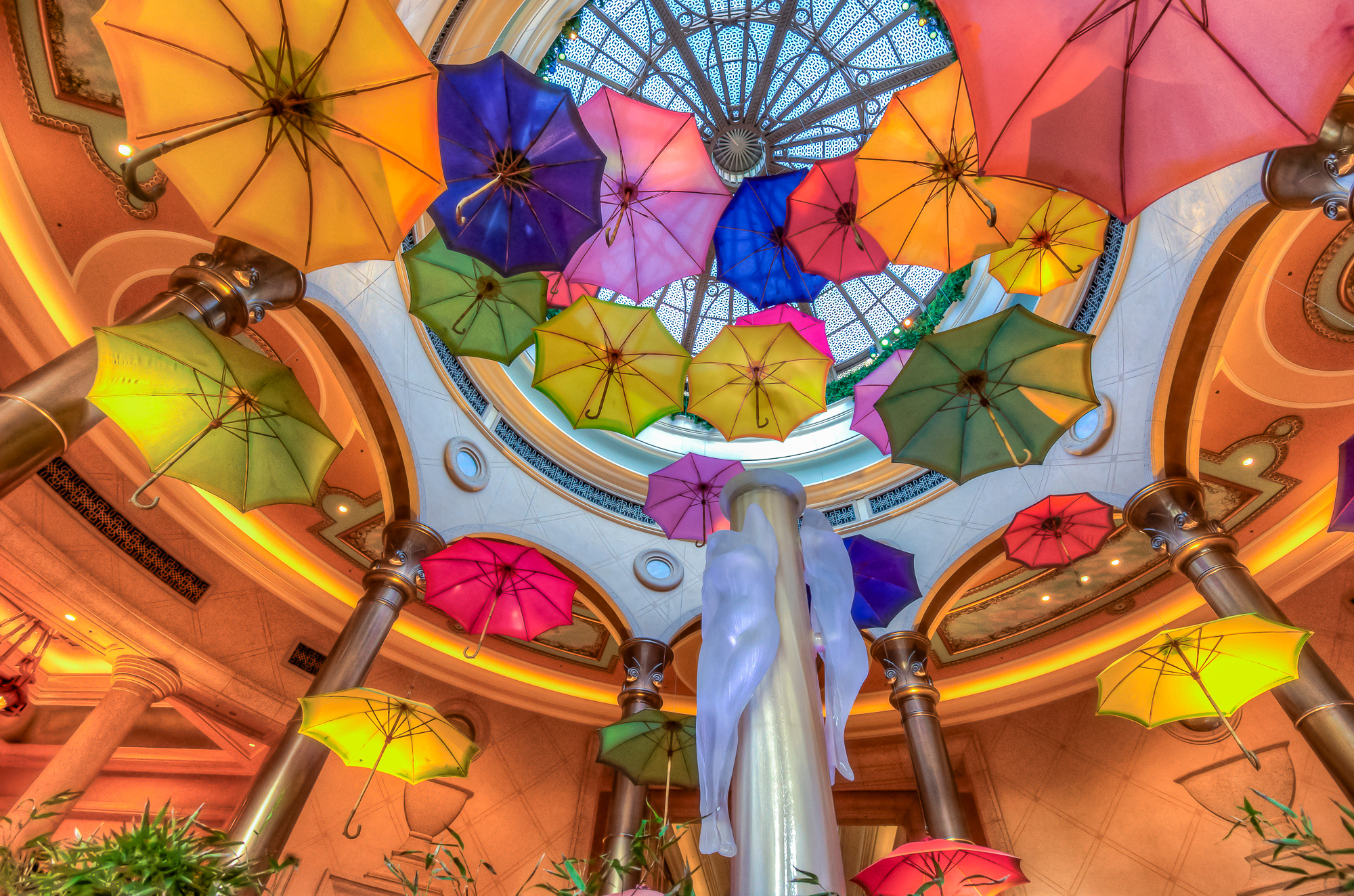
Another city famous for a venue that uses color lighting effectively is Nashville, Tennessee, and its Grand Ole Opry House, famous for hosting the best country music performers in the United States. The stage has a fixed set with variable-colored lights that change with each act. But the real Local Color is the music itself. Performances are year-round.

Large cities aren’t the only ones to decorate their public areas with art. The small seaside city of Del Mar, CA, uses talented mural artists to dress up public places. I thought the modern mural illustrated below was particularly appealing and a great background for my wife as well.
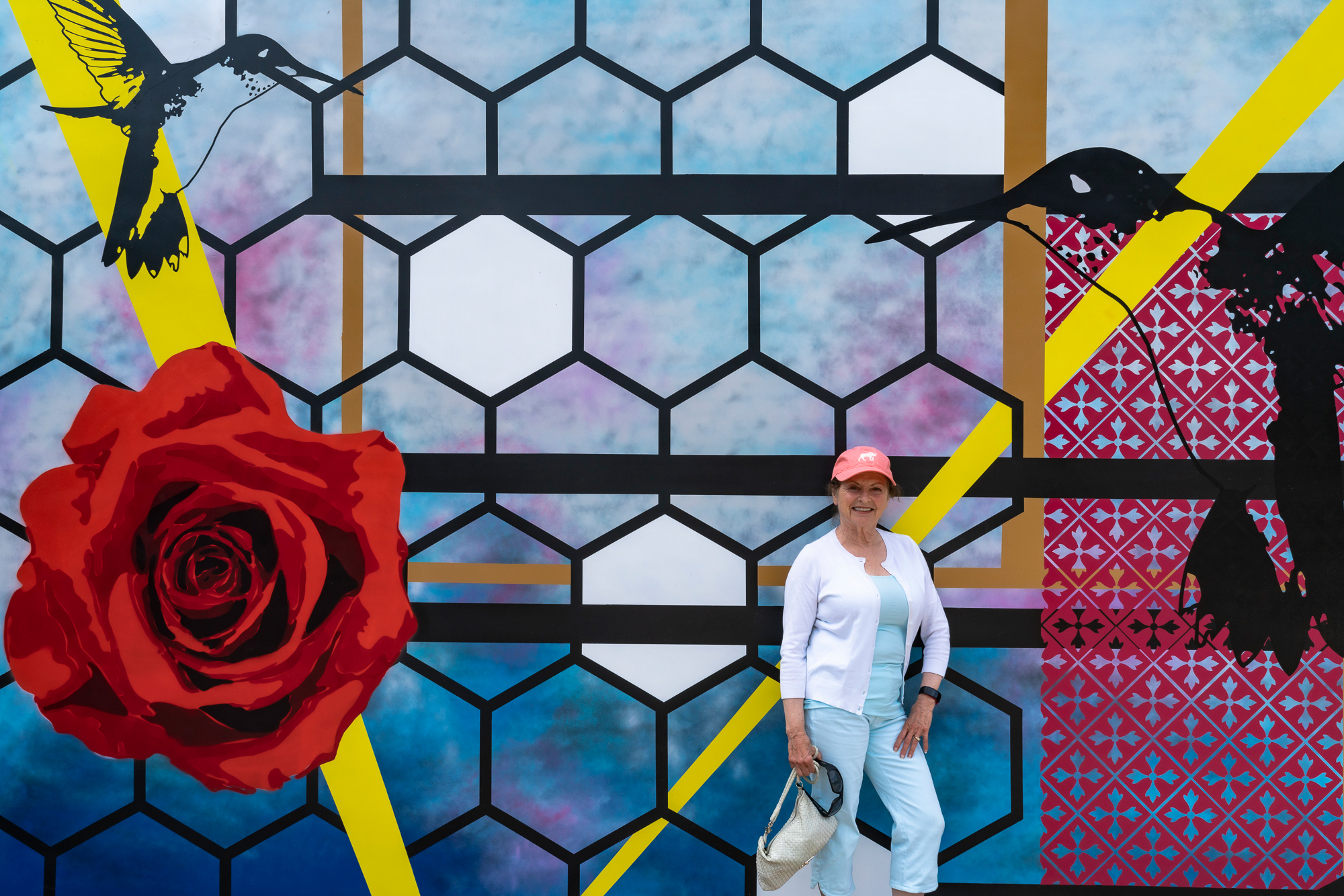
Local color isn’t always the result of a town hall initiative. The city of Laguna Beach, CA, was once a modest seaside village that steadily attracted artists of modest means. They built small, simple homes, many of which lacked proper insulation. These became known as artist shacks. Over time, these became valuable beach properties even though the owners rarely had the funds to maintain them. Few of these remain as the great majority were bought up and replaced by multi-million-dollar houses. Below is one that I photographed that shows the typical peeling-paint charm of these early beach shacks.
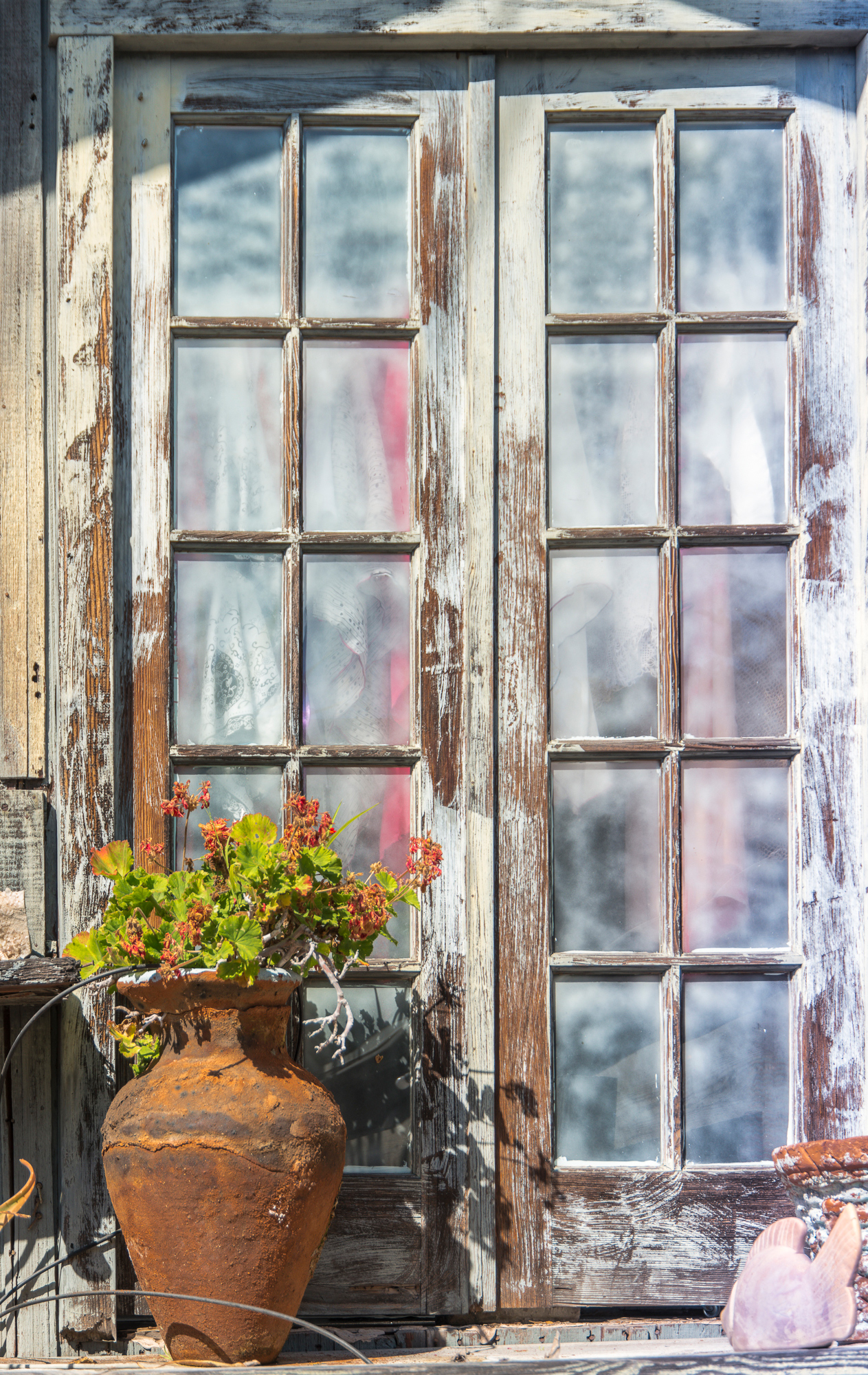
Woodstock is a lovely small city in Vermont that proudly maintains its colonial influences. A classic example appears in the next image of a large colonial-style wood frame building sporting gables and a long driveway. In front, a large formal lawn ends at a deep flower bed of many colors. I felt that there was something missing in the mid-ground and had the presumption to place my wife there with her favorite umbrella that could pass for a color chart.
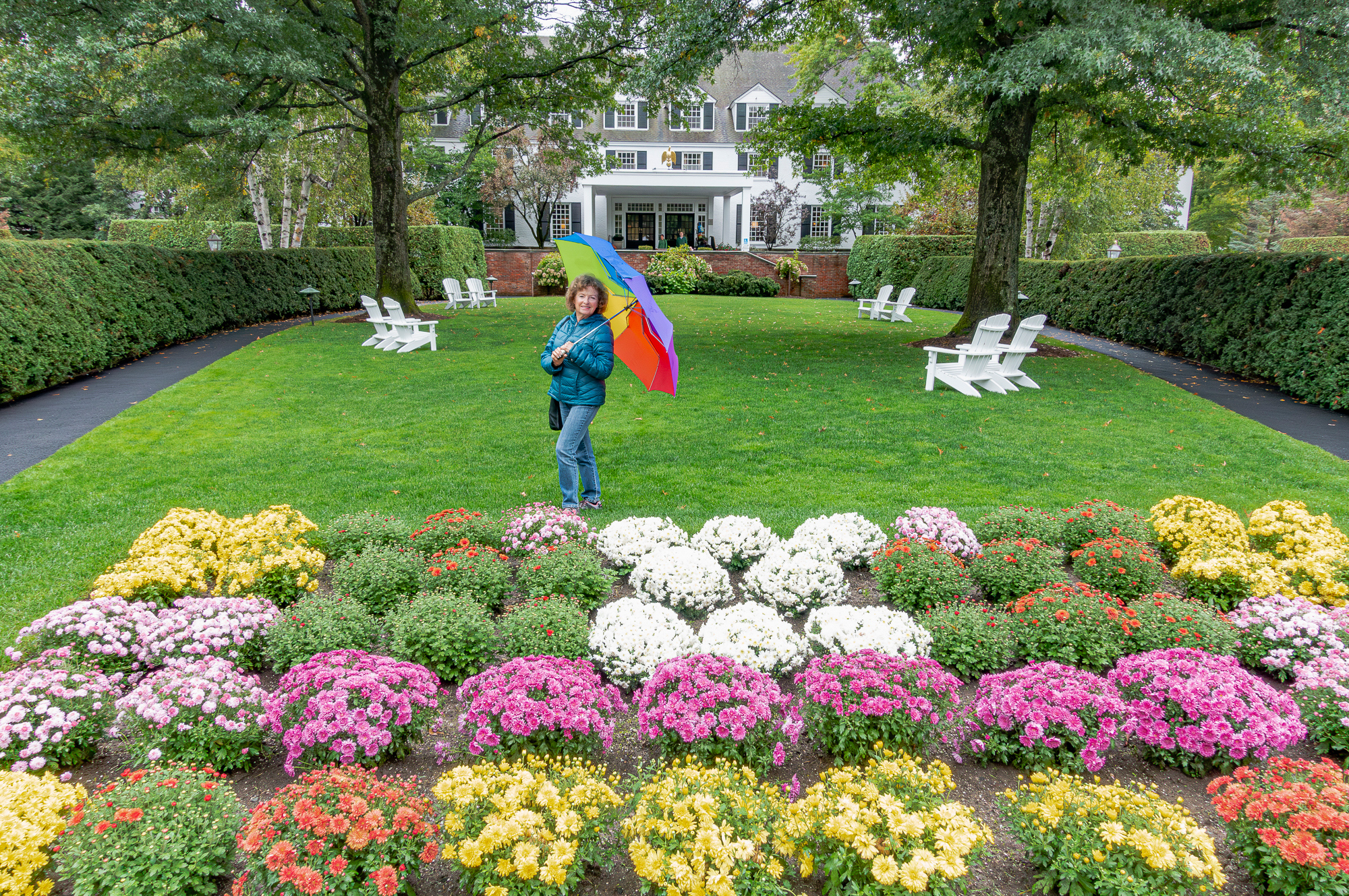
New Englanders are known for their thrift. Though this old but colorful building lies on the grounds of the Von Trapp Family Inn in Stowe, Vermont, it still finds use for some type of business. It may not appeal to many people, but those who love rural New England in Autumn treasure such scenes.
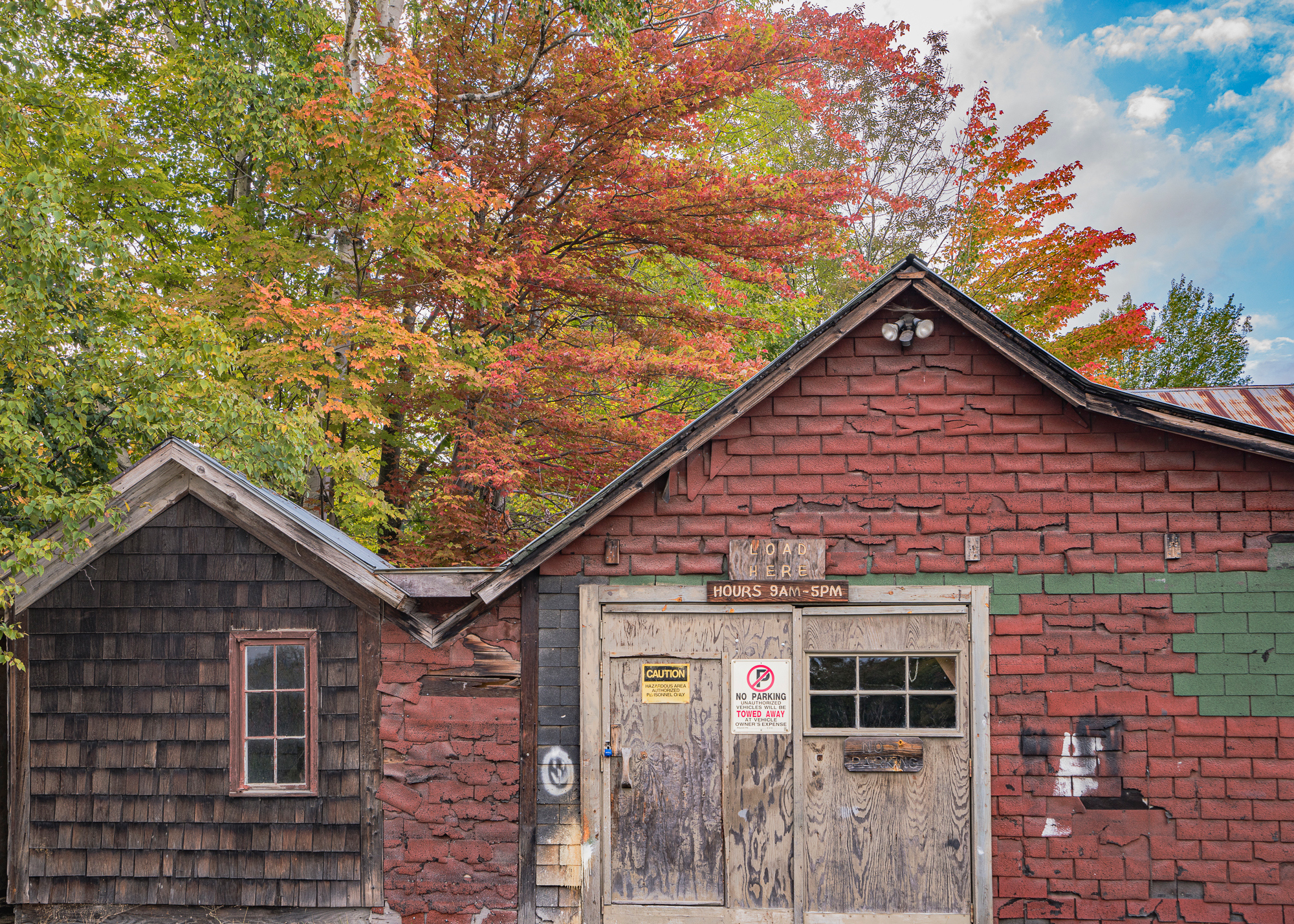
The next image is one of my favorites. We were walking along a street in Charleston, SC, which is known for its large, old mansions when I took notice of a hunched-over old man with his walker. As we drew closer, he stopped in front of one classic house and pulled a camera out of his bag. I thought that he was going to take a picture of the building. Instead, he took a close-up of four white lilies that were growing outside the wrought-iron fence. I couldn’t resist capturing this heartwarming scene and thinking that this could be me in fifteen or twenty years.
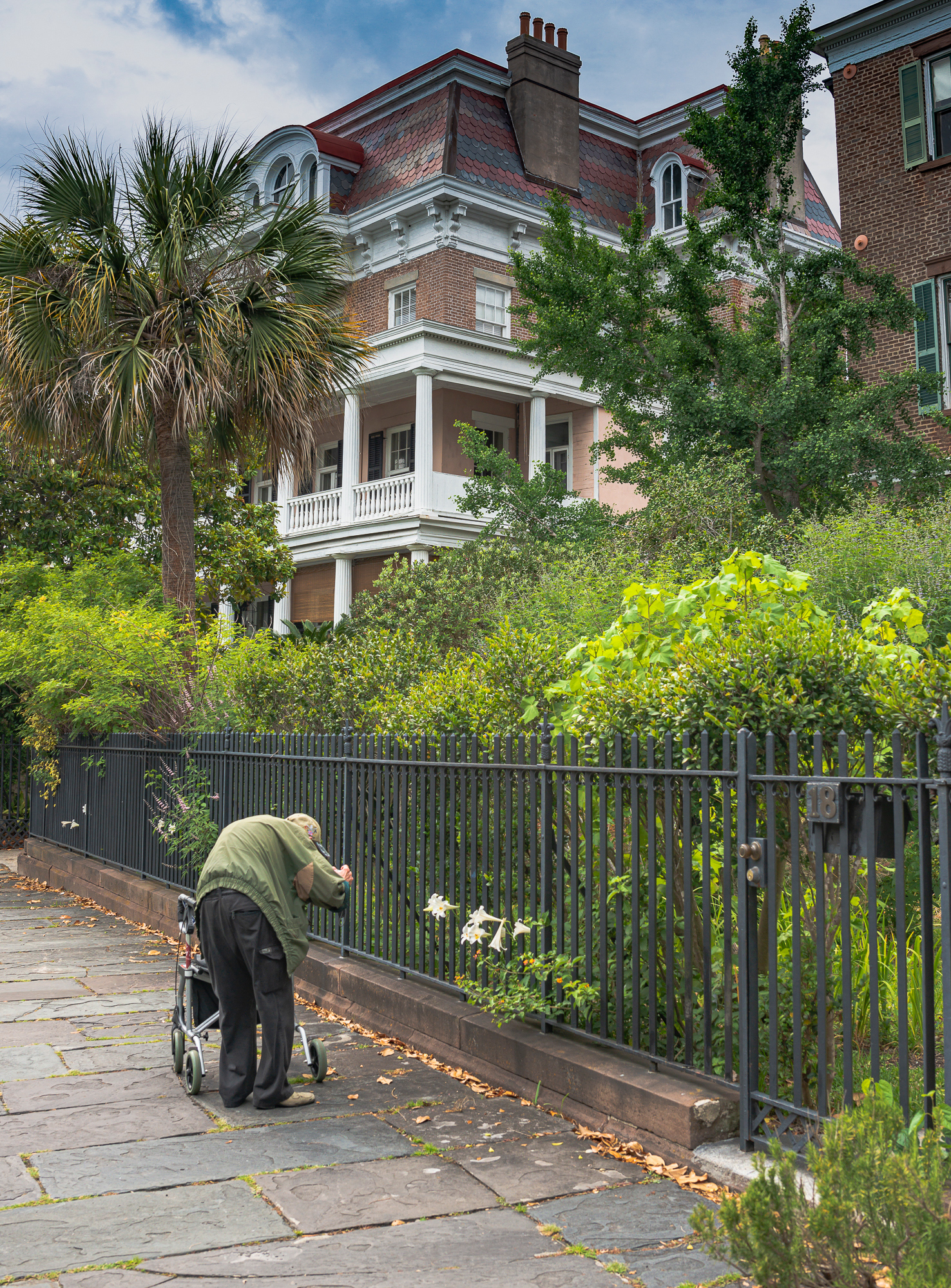
Jerome, AZ, is an old copper and silver mining town that started up in 1876 and was later incorporated in 1899. Like a few other rich mines in the West, its population mushroomed to over 10,000 by 1920. The town suffered catastrophic fires three years in a row, starting in 1898, but managed to rebuild each time and kept booming until the great depression of the 1930s. That, along with acute subsidence caused by a careless practice of cutting new mining tunnels beneath the streets and buildings, made the city a risky place to live. Basically, Jerome has been sliding down the hill ever since. It had been somewhat arrested before I moved to nearby Sedona in 2002. At that time, the population was 47.
Since then, shopping, dining, and entertainment have increasingly attracted both locals and tourists. The current population now stands at 475. The Spirit Room bar is always well attended, particularly by motorcyclists, as shown below. They may dress rough & tumble but often are well-educated and affluent. Some days, the line of parked motorcycles stretches all the way down the block.
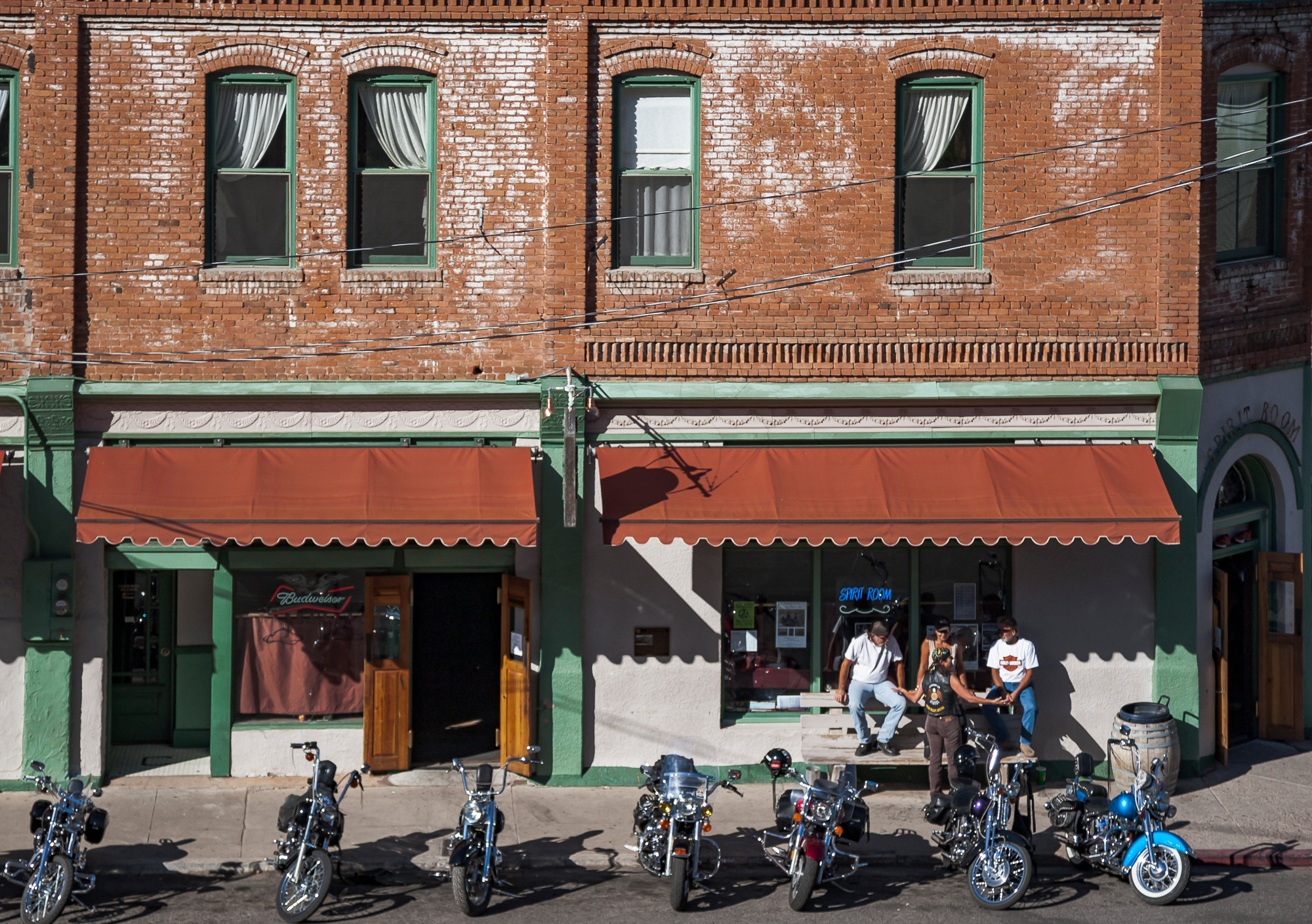
Jackson, Wyoming, was settled as a town in 1892 and incorporated in 1914. It retains many rustic touches, such as the long line of mailboxes shown in the next photograph. But that’s just local color. You must be well heeled to afford a home there; and behind the trees are highly expensive homes overlooking the fairways of the Jackson Hole Golf and Tennis Club.

Local Color is a great way of defining the character and culture of cities and towns throughout the world. It is also both a challenge and an opportunity to capture and create some great photographs. As with portrait photography, photographers who take the time to understand the personality of their subject are rewarded.
The next article in this series will cover some of the photographic opportunities to be found at picturesque events held by many cities and towns.
Please come back soon for Cityscapes Part IV: Major Events.
Harvey Stearn
January 2024
Sedona, AZ
To see the scope and essence of Harvey Stearn's photographic art please visit www.CameraStops.com. Mr. Stearn began photographing Western landscapes and wildlife at the age of 13, spent 50 years pursuing his passion in the field and in the darkroom before fully converting to digital photography in 2002. He developed color prints as well as monochrome, but switched over to digital capture and editing in 2002. Though he was a top executive for two large scale land development and home building corporations, he always found time for his fine art photography which won many awards. His work was exhibited in art museums in Southern California and Arizona, and was also featured in billboard advertisements and published in magazines. Mr. Stearn served on the California Arts Council for nine years, including two years as Chairman and another two as Vice Chairman. In addition, he was the founding Chairman of the John Wayne Airport Arts Commission in Orange County, California. Mr. Stearn’s work was sold through Arizona galleries for 15 years. In recent years he wrote 33 illustrated articles for PhotoPXL.com and 14 articles for Luminous-Landscape.com. In 2013 he published a book entitled “In Search of the Old West” which has been widely acclaimed. He was a guest lecturer on photography on a cruise ship visiting Chile, Argentina, Uruguay and the Falkland Islands. His work was among the top 100 images printed in NANPA's Showcase publications in 2019 and 2020. Images have been edited and selected for two new books on Landscape photography which will be published in late 2024 and early 2025.






